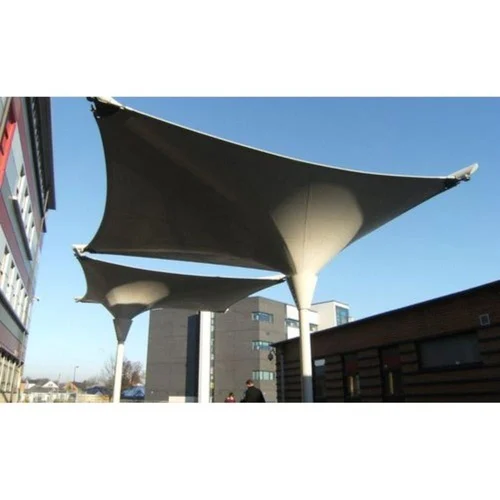Tensile Rain Structure
A Tensile Rain Structure is a type of architectural design that utilizes tensioned fabric or other flexible materials to create a durable, weather-resistant shelter, particularly designed to protect spaces or people from rain. These structures are often used in outdoor environments such as sports arenas, public squares, transit stations, and even private residences, where protection from the elements is necessary while maintaining an aesthetic appeal and functional efficiency.
Here’s a breakdown of key aspects and considerations involved in a tensile rain structure
1. Materials Used
- Tensile Fabrics: The primary material used for tensile rain structures is often high-strength, weather-resistant fabric such as PTFE (polytetrafluoroethylene) coated fiberglass, PVC-coated polyester, or other engineered textiles.
- Steel or Aluminum Frames: The fabric is supported by a framework made from materials like steel or aluminum, which provide the necessary structural integrity to handle wind, snow, and rain loads.
- Carbon Fiber or Kevlar: In some advanced designs, carbon fiber or Kevlar is used for higher tensile strength with lighter weight, though these are less common in standard applications.
2. Design Features
- Tensioning Mechanism: The fabric is stretched under high tension, which gives the structure its strength and stability. This is achieved through a system of cables, masts, or other supports that create a taut surface.
- Curved Geometry: The fabric often takes on a curved or aerodynamic shape, which helps shed rainwater effectively and reduce the load on the structure. This design principle also helps with wind resistance.
- Minimalist Aesthetic: Tensile structures often have a sleek, modern appearance, with clean lines and minimal material usage, which can enhance the visual appeal of the space they cover.
3. Advantages of Tensile Rain Structures
- Lightweight: Tensile structures use less material than conventional solid roofs, making them lightweight and cost-effective while still offering high strength and durability.
- Weather Resistance: The materials used in tensile rain structures are typically weatherproof, UV-resistant, and able to handle various environmental factors such as rain, snow, and wind.
- Design Flexibility: The use of flexible materials allows for creative and innovative designs, from simple canopies to complex, sculptural forms. The tensile membrane can be shaped to fit different spaces, offering both functional coverage and aesthetic appeal.
- Sustainability: These structures often require fewer raw materials and can be more energy-efficient to build. Additionally, their ability to allow natural light to filter through (especially in the case of translucent membranes) can reduce the need for artificial lighting.
4. Applications
- Public Spaces: Tensile rain structures are commonly found in public areas like parks, bus stations, or outdoor event venues, offering shelter while keeping the space open and airy.
- Sports Stadiums: These structures are often used for covering spectator seating in open-air sports stadiums, providing protection from rain without obstructing views.
- Transportation Hubs: Airports, train stations, and bus terminals benefit from tensile rain structures, which can provide large covered areas with minimal support.
- Commercial and Residential: Some private homes, restaurants, and retail spaces may use tensile structures for outdoor dining areas, patios, or garden spaces to provide shelter and create an inviting atmosphere.
5. Challenges and Considerations
- Maintenance: While tensile structures are low-maintenance overall, the fabric material can be subject to wear over time from environmental factors such as UV rays, pollutants, and high winds. Regular cleaning and occasional replacement may be required.
- Wind Loads: Tensile structures must be carefully designed to withstand wind forces. Depending on the location and scale, the fabric must be tensioned enough to avoid flapping or damage but also flexible enough to avoid being torn by gusts of wind.
- Drainage: Proper drainage is essential to prevent water from accumulating on the structure, especially in areas with heavy rainfall. The curvature and slope of the roof should ensure that water flows off easily.
- Structural Support: The masts and frames that support the tensile fabric need to be robust and durable, capable of withstanding both the weight of the fabric and external forces such as wind and snow.
6. Conclusion
Tensile rain structures offer a unique solution to protecting spaces from the elements while maintaining a visually striking and functional design. With their lightweight, flexible materials and ability to span large areas without extensive support, they are an increasingly popular choice for a variety of architectural applications. When carefully designed and executed, tensile structures can provide long-lasting, weather-resistant shelters that enhance both the form and function of outdoor spaces.










.png)